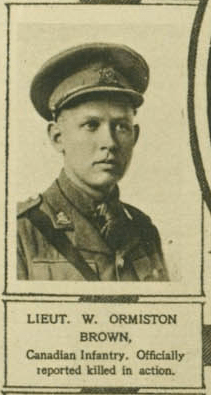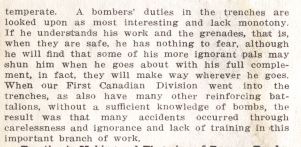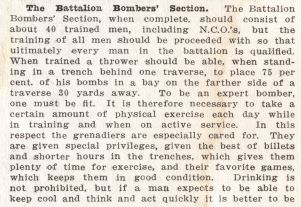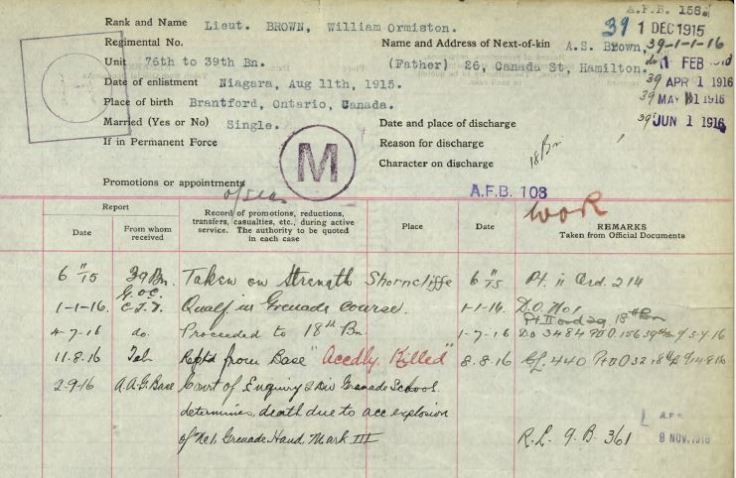Warning: This post contains a graphic description of Lieutenant William Ormiston Brown’s wounds and resulting death.
During the First World War the statistics of accidental death or wounding resulting in death were not kept. During World War II only 7 officers serving were killed accidentally at a rate of 0.3 percent. Accidental deaths for other ranks were an even lower 0.1 percent. One would assume the lessons learned during World War 1 would result in adoption of safety procedures and awareness that helped keep this rate so low, given the inherent dangers of soldiers in training or combat. The increased mechanization and power of personal weapons, such a grenades, made such weapons particularly dangerous to those serving.
In First World War terms if the rate of accidental death is extrapolated 9 Canadian officers died accidentally during this conflict. Several of the accidental deaths found during research to officers and other ranks were typically caused by soldiers interaction with the trench railways (falling off and being run over) to accidental poisoning in the rear areas. In one case a private soldier picked up an unexploded shell in the rear area during a baseball game and it went off killing several soldiers.

The 18th Battalion suffered a tragedy during grenade training as the War Diary entry below relates:
Alberta Camp, August 8, 1916
The 4th Canadian Infantry Brigade relieved the 5th Canadian Infantry Brigade at VIERSTRAAT sector. 18th Canadian Battalion move into Brigade Reserve at LACLYTTE. Lieut. W.O. BROWN accidentally killed. 14 o.r. wounded.
During the war most deaths or wounding were due to enemy action but congregating young men together to do training on the various aspect of their trade would engender an opportunity for accidents to occur. “Bombing” or the training of the use of grenades was considered a highly specialized skill and Lt. Brown had been on a grenade course so it mostly likely fell to him to have this responsibility.

Lieutenant William Ormiston Brown was 23 years old when he volunteered to join the Canadian Expeditionary Forces on August 11, 1915. In Niagara (most like at the Niagara Camp). He was, for that era, a tall 5’ 11” with a fair complexion, grey eyes, and light brown hair. Under is religious affiliation, instead of the usual check mark on the form, is indicated he was a Presbyterian attached to St. Pauls in Hamilton, Ontario. He was a former member cadet of the Highland Light Infantry Collegiate Cadet with whom he served 2 years.
Lt. Wm.O. Brown lists his next of kin as his father, a W.S. Brown, residing at 26 Canada Street in Hamilton, Ontario. His mother’s name was Minnie. He was not married.
On July 1, 1916 he creates a will, refers to his affiliation as belonging to the 18th Battalion, and he leaves his real estate and personal property to his mother.
His particulars of service have him leaving Canada with the 76th Infantry Battalion to the 39th Canadian Reserve Battalion on October 1, 1915. 9 days later he disembarked at Plymouth, England and on November 6, 1915 was Taken on Strength (TOS) with the 39th C.R.B in Shorncliffe. January 1, 1916 he qualified in a Grenade Course. On June 4, 1916 Lt. Brown proceeded to join the 18th Battalion and his arrival was recorded in the War Diary as arriving June 5, 1916. He was killed accidentally by a grenade explosion on August 8, 1916 and on the same day a Court of Inquiry into his death and a report from the 2nd Divisional School of Instruction to the General Staff of the 2nd Division was made.
Lt. Brown’s digitized service records contain the original documents from which this post is drawn from. Please note that the LAC scan has inadvertently included another soldier’s service records and this makes the process of researching him a bit more challenging. The LAC has been informed about this.

A report was subsequently dispatched from the Officer Commanding the 2nd Canadian Divisional School of Instruction on August 8, 1916 to the General Staff of the 2nd Canadian Division regarding the Lt. W.O. Brown in regards to the accident:
“Sir,
I have the honour to report that the marginally noted officer belonging to the 18th Can. Inf. Battalion was killed in an accidental explosion of a grenade in the 2nd Canadian Divisional School area this morning at about 10.15 o’clock.
Lt. Brown was sent down by the O.C. 18th Battalion with 4 N.C.0’s and 40 O.R. to give instruction of bombing. He asked for four specimens of different live bombs and detonators and, while explaining these to his squad who were seated around him on the grass, the accident happened. He was handling a G.S. #1 Grenade and had taken out the cap and inserted a detonator. He then replaced the cap and turned it to “Fire”. He proceeded to explain that pushing down the cap while it was in this position would cause the bomb to explode, and, apparently forgetting that he had inserted a live detonator, he hit the cap a smart blow with his right hand. The Grenade exploded killing Lieut. Brown and wounding 14 O.R.
We informed the Division by phone and ambulances were set down at once to remove the wounded.
To prevent recurrence of such an accident in future I would respectfully recommend that sets consisting of various British Grenades be prepared by removing all explosives and that a set of these dummy grenades be furnished [to] each Battalion in the Division, to be used for training purposes.
I beg to attach depositions taken from…
The Court of Inquiry was convened by the 2nd Canadian Divisional Grenade School by order of Major H.L. Milligan, the officer commanding the 18th Battalion. The President of the Board was Major C.O. Fairbanks with the following members: Major R.R. Barber, Captain W.J. Gander, and Lieutenant W.S. McClinton, all of the 18th Battalion.
The court took depositions from witnesses.
Acting Corporal J.B. Brown, Regimental no. 54149 attached to the Sub-Staff, Divisional School stated –
Mr. Brown of the 18th Battalion came to me in the office about 9.40 a.m. and said that he had some new men whom he had brought for Grenade work. He arranged to practice throwing dummies sometime after 10.00 a.m. and in the meantime wished to instruct the men in different kinds of grenades and asked me to give him grenades for that purpose. I told him I had none that were unloaded, he said that did not make any difference, that he would take the loaded ones. He accompanied me into the magazine, where I gave him the grenades, (Mills No. 5, G.S. No. 1, Newtown Pippin Rifle Grenade, and No. 19 Grenade) these Grenades he asked for by name. I examined the condition of the grenades before giving them to him, they were loaded and in good working order, but had no detonators in them. These he took away but returned a few minutes later and asked me for detonators. I told him I had no dummie [SIC] detonators, so he said the live detonators would do as well. I gave him one detonator for each of the No. 5, Mills, No. 1 G.S. and the Newton Pippin Rifle Grenade. He said he would turn these in before he started throwing. The No. 1, Hand Grenade (General Service) came from a box marked; – “10 – Grenades Hand – No. 1, M.K. III – W, 18-4-1916.”
Sergeant Charles Hessey, Regimental no. 53342, 18th Battalion stated:
Lieut. Brown left ALBERTA CAMP at 9.30 a.m. in charge of “B” Company Bombers, 18th Battalion, consisting of 4 N.C.O’s, and forty men. I am not a bomber, but, was sent down for instructions. A squad arrived at the 2nd Cdn. Divisional School of Instruction at 9.45 a.m. Lieut Brown went over to the Quartermaster Stores and got some bombs, including a No. 5 Mills, G.S. No. 1, Newton Rifle Grenade and No. 19 Percussion. Lieut. Brown had the Squad drawn around him and sit down while he explained the bombs. He explained the No. 5, Mills, the No. 19, and was explaining the G.S. No. 1, when it exploded. He picked up the G.S. No. 1, and was telling the Squad the name of the Grenade, the method of throwing, it, the name of explosive, T.N.T. He then picked up the detonator from the ground and said this is a dummie [SIC] detonator. He then put the detonator in the grenade, put on the cap with the safety pin out, he explained the meaning of, “Remove”, “Travel” and “Fire”, then turned the cap to “Fire” and said, “When it lights” he then hit the cap with his right hand, and the bomb exploded.
Corporal George Evans, Regimental no. 54122, 18th Battalion stated:
I was one of the Class to whom Mr. Brown was demonstrating the working of the various bombs. He was explaining the G.S. No. 1, to the Class. He put the detonator in the bomb and took it out, held it up and said “This is a dummie detonator”, he then put it back into the bomb, put on the cap and explained the working of the cap. Striking cap with his had the bomb exploded.
Private C.O. Carpenter [an American who joined to fight for Canada], Regimental no. 54250, 18th Battalion stated:
Mr. Brown explained the working of the No. 5 Mills and the No. 19 Bombs, he then took up the No. 1 G.S. Bomb and started to explain it to us. He picked up the detonator from the ground and said it was a dummie detonator. He put the detonator in the bomb, put the cap on without safety pin in cap, he then explained the three points, Remove, travel and fire, turning the cap to fire holding the bomb in his right hand. He said, “When the Bomb lights” he then struck cap of the bomb with his left hand and the bomb exploded, and Mr. Brown fell and a number of the Class were injured.
Lieutenant Elliot Cay, Staff Divisional School, stated:
On the morning of Aug. 8th, 1916, owing to absence of Lieut. B.O. Hooper, I was in charge of the 2nd Cdn. Divisional School. At about 10.15 a.m. I was lecturing in the School Lecture Hall which is situated in rear of the Quartermaster Store, and while there heard an explosion. Knowing this explosion did not take place in the authorized throwing area I went out to investigate. I was informed that while lecturing to his Squad on Grenades, Lieut. Brown of the 18th Battalion had, had a Grenade explode in his hands. I saw Lieut. Brown on the ground, he had a big hole in the abdomen and his bowels were protruding, his right hand blown off at the wrist and his face badly cut, he was barely breathing. Ambulances where immediately called for and the matter reported to the General Staff, 2nd Cdn. Division, by Captain F.F. Montague, (G.S.O. 3) who was at time of accident in the School area. The ambulances arrived and on assembling the wounded found they were fourteen, excluding Lieut. Brown.
The opinion of the Court of inquiry summarized that the death of Lieutenant Brown was accidental and was not due to “any defect in manufacture of the Grenade.” They also did not assign any blame to any soldier or to the victim of the accident.
A report was subsequently dispatched from the Officer Commanding the 2nd Canadian Divisional School of Instruction on August 8, 1916 to the General Staff of the 2nd Canadian Division regarding the Lt. W.O. Brown in regards to the accident:
“Sir,
I have the honour to report that the marginally noted officer belonging to the 18th Can. Inf. Battalion was killed in an accidental explosion of a grenade in the 2nd Canadian Divisional School area this morning at about 10.15 o’clock.
Lt. Brown was sent down by the O.C. 18th Battalion with 4 N.C.0’s and 40 O.R. to give instruction of bombing. He asked for four specimens of different live bombs and detonators and, while explaining these to his squad who were seated around him on the grass, the accident happened. He was handling a G.S. #1 Grenade and had taken out the cap and inserted a detonator. He then replaced the cap and turned it to “Fire”. He proceeded to explain that pushing down the cap while it was in this position would cause the bomb to explode, and, apparently forgetting that he had inserted a live detonator, he hit the cap a smart blow with his right hand. The Grenade exploded killing Lieut. Brown and wounding 14 O.R.
We informed the Division by phone and ambulances were set down at once to remove the wounded.
To prevent recurrence of such an accident in future I would respectfully recommend that sets consisting of various British Grenades be prepared by removing all explosives and that a set of these dummy grenades be furnished [to] each Battalion in the Division, to be used for training purposes.”
It is interesting to note the speed in which the Court of Inquiry was convened and the information forwarded to higher authority, all on the same day. In an environment already made dangerous by the engagement of the enemy and using the tools in order to fight them a Canadian soldiers’ world was already dangerous enough. It appears the Canadian Army took this issue very seriously and engaged in prescriptive measures immediately.
Perhaps part of the fault in this tragic accident is the time from which he took his grenade course and qualified (January 1, 1916) until the time he was involved in actual training, a full 8 months later.
Further Reading:
The Regimental Rogue web site has a great overview of this issue.
Gray, Lewis: reg. no. 159093 wounded in incident.
Morykwas, Alexander AKA Marquie, Alex: Service no. 141024 wounded in incident.


